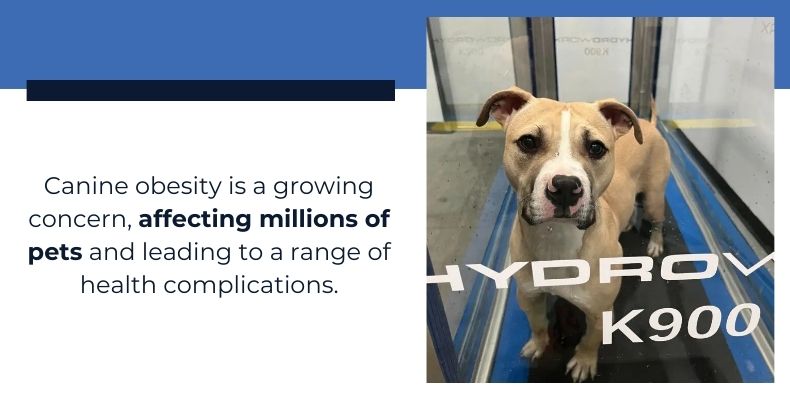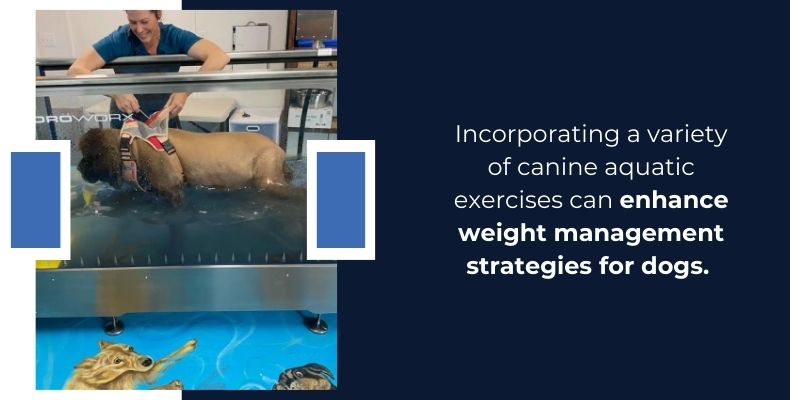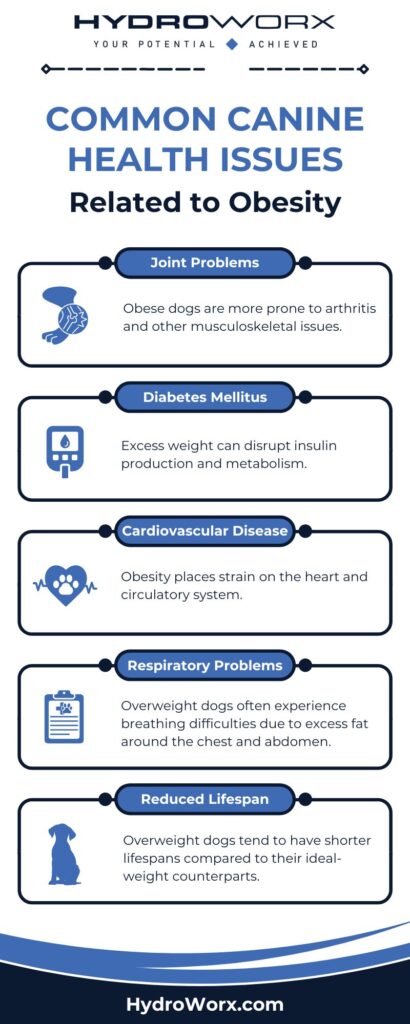Aquatic Exercise Programs for Canine Weight Management: Helping Dogs Stay Fit and Healthy
Maintaining a healthy weight for dogs is essential for their overall well-being and longevity, making effective weight management strategies vital for veterinary clinics. As canine obesity continues to rise, the need for innovative treatment options has never been more urgent. Aquatic exercise programs are an effective solution, providing a low-impact environment that promotes weight loss, improves cardiovascular health, and enhances muscle strength.
Utilizing advanced technology like the HydroWorx K900, veterinarians can integrate aquatic therapy into their practices, tailoring rehabilitation programs specifically for overweight and at-risk dogs. Today’s article from HydroWorx explores the significance of aquatic exercise for canine weight management and how clinics can implement these programs to help their patients achieve healthier lifestyles.

Understanding Canine Obesity
Canine obesity is a growing concern, affecting millions of pets and leading to a range of health complications. Recent statistics indicate that about 59% of dogs in the United States are classified as overweight or obese, which can significantly impact their quality of life. Common causes of weight gain include overfeeding, lack of exercise, and underlying medical conditions such as hypothyroidism or Cushing’s disease. Additionally, certain breeds are predisposed to obesity, making it imperative for veterinarians to recognize at-risk populations.
The health implications of obesity in dogs are profound. Overweight dogs are more prone to developing conditions such as diabetes, arthritis, heart disease, and respiratory problems, which can lead to a decreased lifespan and diminished overall well-being. As veterinary professionals, implementing proactive weight management strategies is essential for promoting healthy weight maintenance among canine patients. This involves a comprehensive approach that includes dietary counseling, exercise recommendations, and regular monitoring. By understanding canine obesity and its consequences, veterinary clinics can better educate pet owners and provide targeted interventions, helping their patients live healthier, happier lives.
Benefits of Aquatic Exercise for Dogs
Aquatic exercise offers numerous benefits for dogs, particularly those struggling with obesity or recovering from injuries. Some key benefits include:
- Low-Impact Workouts: Water’s buoyancy reduces stress on joints, making it ideal for older dogs or those with arthritis. This allows for more comfortable movement and safer exercise experiences.
- Increased Resistance: The natural resistance of water enhances muscle strengthening and endurance, promoting faster weight loss and improved fitness levels.
- Enhanced Cardiovascular Health: Aquatic exercises can improve heart and lung function, leading to better overall health.
- Mental Engagement: Water-based activities can be stimulating and enjoyable for dogs, promoting mental wellness and reducing anxiety.
- Safety and Supervision: Conducting exercise in a controlled aquatic environment allows veterinarians to closely monitor the dog’s progress and well-being during sessions.

Designing an Aquatic Exercise Program
Creating an effective canine aquatic exercise program involves several key components that cater to the individual needs of patients. Consider the following steps:
- Initial Assessment: Begin with a thorough evaluation of the dog’s health status, weight, and physical limitations. Consult veterinary professionals to identify any underlying concerns.
- Set Goals: Establish clear, achievable objectives based on the canine’s health needs and desired outcomes (e.g., weight loss, increased strength, improved mobility).
- Frequency and Duration: Recommend sessions that balance intensity and endurance. Typically, sessions should last 20-30 minutes, two to three times per week.
- Tailoring Exercises: Customize the program by incorporating various aquatic exercises suited to the dog’s size, breed, and conditioning level.
- Regular Monitoring: Consistently assess progress and adjust the program as needed to ensure continued improvement and prevent injury.
Types of Aquatic Exercises for Weight Management
Incorporating a variety of canine aquatic exercises can enhance weight management strategies for dogs. Here are some effective options:
- Underwater Treadmill Sessions: The HydroWorx K900 offers controlled speed and resistance, allowing dogs to walk or run at their own pace, which is excellent for cardiovascular conditioning and muscle building.
- Swimming: Encouraging dogs to swim promotes natural movement and engages multiple muscle groups. Swimming can be done in heated pools to enhance comfort and maintain body temperature.
- Water Retrieval Games: Using toys for retrieval exercises can motivate dogs to engage in play while exercising. This method combines mental stimulation with physical activity.
- Resistance Training: Incorporating water jets or buoyancy aids into exercises provides additional resistance, promoting muscle strength and endurance during workouts.
- Hydrotherapy Exercises: Tailored hydrotherapy sessions focusing on rehabilitation methods can improve mobility and help dogs transition to land-based activities effectively.

Monitoring Progress
Monitoring progress is crucial for assessing the effectiveness of aquatic exercise programs for canine weight management. Regular weigh-ins and body condition scoring can help veterinarians track changes in the dog’s weight and overall health. Additionally, observing improvements in fitness levels, such as increased stamina and enhanced mobility, can provide valuable insights into the program’s success. Utilizing technology, such as tracking software or fitness assessments, enables veterinary teams to adjust exercise regimens as needed to optimize outcomes.
How the HydroWorx K900 Can Help
The HydroWorx K900 is specifically designed for the rehabilitation of small to medium-sized animals and can significantly enhance aquatic exercise programs for canine weight management. Featuring an underwater treadmill, the K900 allows dogs to exercise efficiently in a controlled environment, minimizing stress on their joints while utilizing the therapeutic benefits of water. The system’s adjustable speed and resistance settings cater to each dog’s individual needs, promoting effective cardiovascular conditioning and muscle strengthening.

Schedule a Demo of the HydroWorx K900
Integrating aquatic exercise programs into veterinary practices provides an effective strategy for managing canine obesity and improving overall health. The benefits of low-impact workouts, combined with targeted aquatic exercises, can significantly enhance dogs’ well-being and quality of life. By utilizing the HydroWorx K900, veterinary clinics can offer specialized rehabilitation services, promoting better outcomes for their patients. Contact us today to learn more about how the HydroWorx K900 can transform your approach to canine weight management and rehabilitation.

